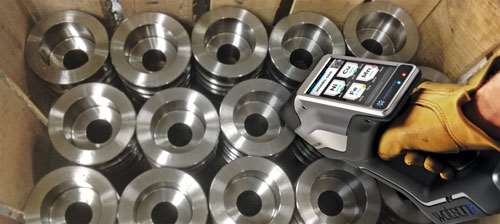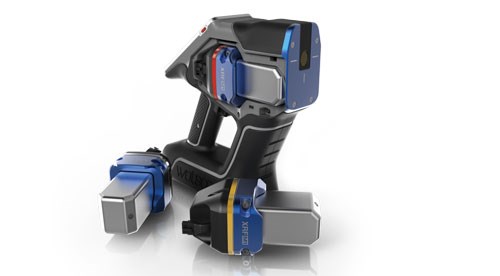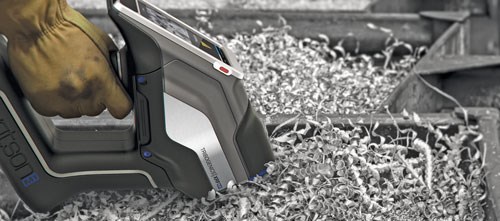A New Look at Material Verification
Handheld X-ray fluorescence (XRF) analyzers have become a standard for non-destructive elemental analysis, testing and inspection in a range of industrial and consumer applications.
When a shop places an order for material, it knows and communicates clearly to the supplier exactly what it needs, based on the specs provided by its customer for the final part. While typically reliable, the materials supplier’s accuracy for providing exactly the right material can require verification, for purposes of traceability (particularly in aerospace, fabrication and recycling applications) or perhaps only to put the customer’s mind at ease when the product is delivered. Often, shops take the traceability requirements a few steps further, continuing to verify the materials through the production process, all the way up to shipping.
Handheld X-ray fluorescence (XRF) analyzers have become a standard for non-destructive elemental analysis, testing and inspection in a range of industrial and consumer applications. These XRF guns use a small burst of X-rays to identify metals and metal alloys. Useful for any material from aluminum to uranium, they will identify the specific elements on the periodic table in their various proportions and reference them to specify particular grades and whether or not the material is to spec.
Featured Content
Common in such devices is technology originally developed in the 1800s that relies on expensive, high voltage transformers to generate X-rays. But recently, with the help of DARPA and in collaboration with UCLA, Tribogenics has developed technology that it says eliminates the need for these high voltage products, incorporating a process similar to static electricity (known as the triboelectric effect).
A New Approach
Called Watson XRF, Tribogenics’ XRF product instantly identifies, analyzes and tests a range of metals and alloys for positive materials identification (PMI), scrap metal recycling, quality assurance and quality control for metal fabrication, machining and manufacturing. What sets the product apart, according to Dale Fox, company CEO, is that this newer X-ray technology allows the product to be priced substantially less than traditional units—around $10,000. Mr. Fox says it has the same performance as other units along with a few other features.
The X-ray source that Watson uses lasts a few months, on average, but unlike traditional units, the source is interchangeable like an inkjet printer cartridge and costs about $300. This capability makes it practical for a shop to keep an extra X-ray source on hand so that when one goes down, the next can be plugged in to eliminate any downtime. Mr. Fox says units that use conventional technology can experience downtime of 4 weeks or more, and repair is more costly.
Because Watson’s X-ray source is easily interchangeable, different kinds can be used for different applications. While most shops will only require one type of X-ray source (which handles the same range of materials as the traditional XRF units), other sources are available to analyze a more diverse range of materials such as precious metals.
On the Shop Floor
The user interface is designed on the Android platform with Wi-Fi for quick transfer of data. The screen looks and functions similarly to an Android phone. As Tribogenics upgrades its software with new features or improved algorithms, the updates are automatically uploaded to the Wi-Fi-connected units, in the background, without interruption of operation. Information can also be downloaded from Watson to a personal computer for data collection.
A common need is in verifying incoming stock. “Once a shop verifies what it is, they’re often comfortable with processing the material through the shop,” Mr. Fox says. “Traceability requirements are forcing shops to be more diligent about knowing exactly what the stock is when it comes in—that it is to spec with what they ordered. It’s important to check the material on the inbound because once it’s processed, if it’s the wrong material, they’ve lost a lot of money, both in material and in production time.” When the parts are complete, they can be analyzed again to confirm that the material is to spec.
An Ounce of Prevention
Because of the traditional cost of X-ray technology, machine shops often struggle to justify such an equipment purchase. Managers may feel that the few related problems they encounter are all a part of the expense of doing business. But delivering bad parts not only costs money in rework, but also creates strain in customer relationships.
Mark Valentine, COO with Tribogenics, previously owned a chain of machine shops. He explains that in those early days, such technology could have saved him a lot of money. “I was delivering parts for the medical X-ray industry, but I wasn’t aware of XRF technology,” he says. “In a single job, we used the wrong material and delivered parts to the customer. Their rejection of the parts cost us $40,000. You can practically eliminate that risk with far less cost, and not only make sure you’re receiving and delivering the right material, but prove with data that you’re doing so.”









